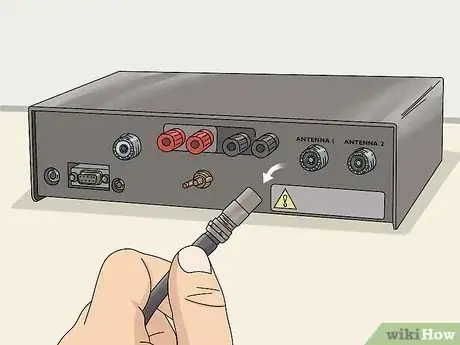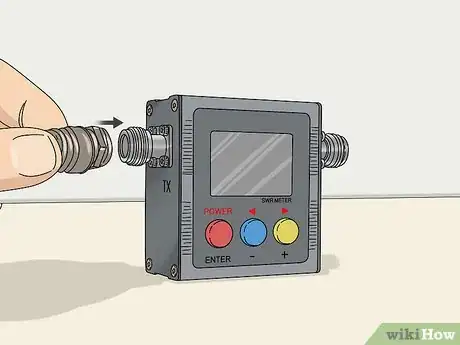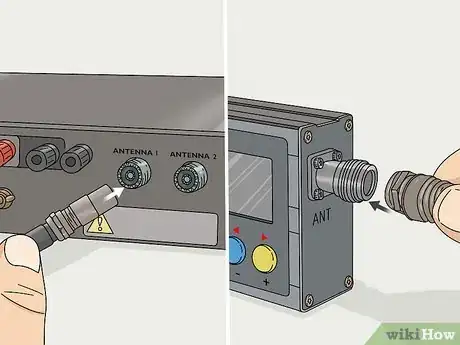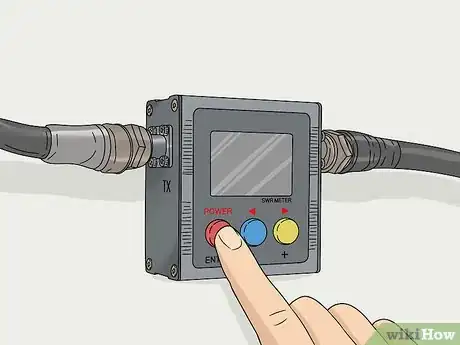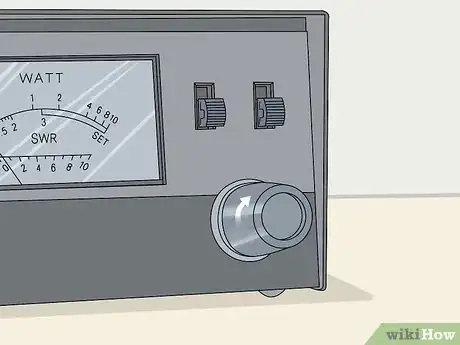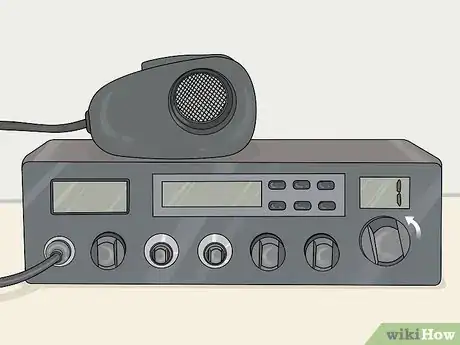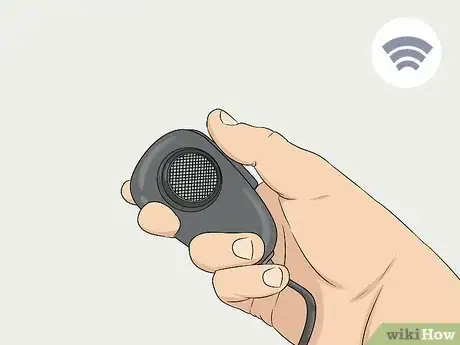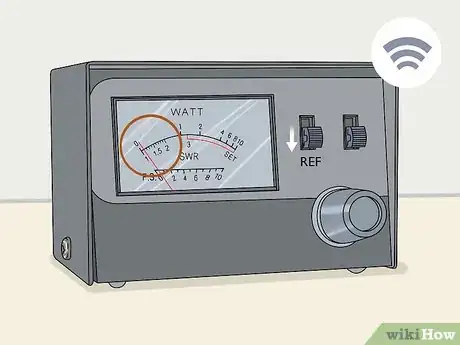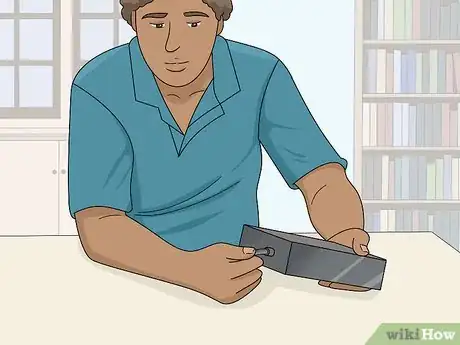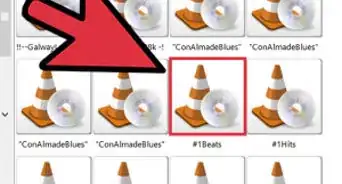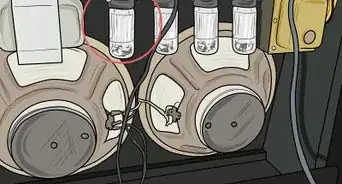This article was co-authored by wikiHow Staff. Our trained team of editors and researchers validate articles for accuracy and comprehensiveness. wikiHow's Content Management Team carefully monitors the work from our editorial staff to ensure that each article is backed by trusted research and meets our high quality standards.
There are 10 references cited in this article, which can be found at the bottom of the page.
This article has been viewed 27,838 times.
Learn more...
An SWR (short for “standing wave ratio”) meter is a calibration tool used to measure the standing wave ratio of a CB ("citizens band") radio, a type of short-distance radio system that allows users to communicate over a limited number of channels. Knowing how to find your radio's SWR value is important, as it allows you to adjust the antenna for optimal reception. To run a test, simply connect your radio’s coaxial and antenna cables to the indicated ports on the meter. When you set the meter for calibration and activate the radio transmitter, you’ll see a number indicating the strength of the signal being broadcasted.
Steps
Connecting the Meter
-
1Conduct your test at least 20 feet (6.1 m) from any nearby structures. In order to get the most reliable reading possible, you’ll need to make sure that there’s nothing that might block the radio signal from getting to your antenna. If there are tall buildings, trees, or similar obstructions around, you may end up with a reading that doesn’t accurately reflect your radio’s current calibration.[1]
- The best place to operate an SWR meter is in a clear, open area, such as a parking lot or field.
- Ask anyone in your immediate vicinity to stand a minimum of 20 feet (6.1 m) away from your radio. If they’re crowding the antenna, they could get in the way of the outgoing signal.
- You can pick up an SWR meter from any major electronics store or CB radio specialty shop, as well as online. Basic models range in price from around $30-100, while more powerful meters will often run you several hundred dollars.[2]
Warning: Avoid testing your radio in a garage, carport, or other enclosed space where the surrounding walls may have a distorting effect.
-
2Disconnect the antenna and coaxial cables from your radio. A standard coaxial cable is a thick black cord with a screw-on barrel head. Antenna cables tend to be slightly thinner, and may be designed to attach to a separate external antenna piece. You’ll find both of these components plugged into the back of the radio. To remove them, simply unscrew them and pull them free from their respective ports.[3]
- Your radio's main component cables may look very similar, so be sure to keep up with which is which if they’re not labelled.
- Since your SWR meter is designed to test whether the antenna is correctly calibrated to send and receive signals, it needs to go between your radio’s transmitter and antenna.[4]
Advertisement -
3Connect your radio’s coaxial cable to the transmitter port on your meter. This port will be located either on the side or back of a standard SWR meter. It should be marked “transmitter” or “XMIT.” Insert the prong of the coaxial cable into the hole at the center of the port, then rotate the barrel head clockwise until it's cinched down firmly.[5]
- The coaxial cable for a CB radio is sometimes referred to as a “jumper lead.” Keep this in mind if you're following along with your radio's owner's manual.
- If your SWR meter includes its own built-in connectors, you’ll need to connect your cable leads to them instead.
-
4Run your radio’s antenna cable to the antenna port on the SWR meter. Like the transmitter port, your meter’s antenna port should be labelled either “antenna” or “ANT.” Connect the antenna lead from the radio to the corresponding meter port the same way you did the coaxial cable, then take a moment to make sure it’s secure.[6]
- Double-check that both leads are configured for the correct ports before you continue. If they’re not, the readings you get back will be skewed and unhelpful.
Taking a Reading
-
1Locate the power button or switch on a digital meter to activate the unit. Most newer SWR meters feature a central power button on the face of the device. On some models, you may find a power switch on the side or back of the unit's casing. Your meter’s display screen will light up when you turn it on.[7]
- If you’re working with an older analogue meter that doesn’t have a power button, make sure that the “Function” switch is toggled to the “FWD” position to start with.[8]
- If you happen to press a wrong on your digital meter by accident, you can restore the device’s default settings at any time by switching it off and back on again.
-
2Turn the calibration dial on analogue meters to the indicated zone. You must set analogue meters for calibration manually. To do this, find the dial marked “Calibration” and rotate it in a clockwise direction. Keep turning the dial until the needle on the display window comes to a stop against the far right edge of the area highlighted in red.[9]
- Once you’ve set your meter, it will be primed to provide a reading with the flip of a switch.[10]
-
3Set your radio to channel 1. Turn the channel dial on the radio interface to the left, or press and hold the down arrow button under the display until you reach channel 1. This is the lowest frequency on a CB radio, and the place where you’ll begin your calibration.[11]
- Later on, you’ll also be checking channel 40, the highest frequency. The idea is to gauge the antenna’s average signal strength by taking a reading from both ends of the radio’s frequency range.
-
4Press and hold the transmitter button on your radio’s hand microphone. “Keying” the hand mic, as it’s known in CB circles, activates the radio’s internal transmitter. This is the signal that your SWR meter will be measuring. Be sure to hold the button down the entire time that you’re conducting a reading.[12]
- Newer SWR meters typically provide automatic readings as soon as you depress the transmitter button on your radio’s hand mic.[13]
-
5Flip the function switch over to “REF” and record the value shown. As you move the switch, the needle on the window display will jump to the position corresponding to the SWR value for that channel. Write down this number for future reference.[14]
- A reading of 1-1.5 indicates optimal signal strength. As long as the number you see is below 2, though, it means that your radio and antenna are calibrated properly.[15]
- Don’t release the transmitter button until you’ve made a note of the SWR value. The reading will disappear as soon as you let go.
-
6Repeat the process on channel 40. After finding the SWR of channel 1, scan over to channel 40 and check the opposite end of your radio’s frequency range, then compare the two readings. The closer they are, the more stable the signal. Ideally, the numbers should be within a few decimal places of one another.[16]
- If you like, you can also test the SWR on channel 20 to get a clearer idea of the signal’s consistency across the entire frequency range. However, this is not a necessary step.
Tip: It’s important to hold the microphone the same distance away from the transmitter for each test. Even a small change of position could throw off subsequent readings.
-
7Make adjustments to your radio or antenna as needed. If you get back an SWR value greater than 2, it either means that your antenna is the wrong length for your radio or that there’s a defect within the transmitter itself. Most often, a short or grounding issue is to blame. Consult your owner’s manual to find solutions for common problems or take your radio to a qualified technician to have it worked on professionally.[17]
- Tuning an antenna involves cutting it to a length that’s more suitable for the frequency being used. This is a highly technical project that you shouldn't attempt without the necessary knowledge and experience.[18]
- It may not be safe to operate your CB radio if it’s not calibrated properly.
References
- ↑ https://www.youtube.com/watch?v=i42AJfKH04M&feature=youtu.be&t=104
- ↑ http://cbradiomagazine.com/Accessory%20Reviews/HP202S%20Meter/Workman%20HP202S%20SWR%20Meter.html
- ↑ https://www.electronics-notes.com/articles/antennas-propagation/vswr-return-loss/how-to-use-vswr-meter.php
- ↑ http://www.cbradiomagazine.com/Articles/How%20to%20use%20a%20SWR%20meter.htm
- ↑ http://www.cbradiomagazine.com/Articles/How%20to%20use%20a%20SWR%20meter.htm
- ↑ https://www.electronics-notes.com/articles/antennas-propagation/vswr-return-loss/how-to-use-vswr-meter.php
- ↑ https://www.youtube.com/watch?v=i42AJfKH04M&feature=youtu.be&t=76
- ↑ http://www.cbradiomagazine.com/Articles/How%20to%20use%20a%20SWR%20meter.htm
- ↑ https://www.youtube.com/watch?v=jRWKZskxcs0&feature=youtu.be&t=84
- ↑ http://www.cbradiomagazine.com/Articles/How%20to%20use%20a%20SWR%20meter.htm
- ↑ http://www.techlib.com/reference/CB.htm
- ↑ http://www.cbradiomagazine.com/Articles/How%20to%20use%20a%20SWR%20meter.htm
- ↑ https://www.youtube.com/watch?v=i42AJfKH04M&feature=youtu.be&t=125
- ↑ http://www.cbradiomagazine.com/Articles/How%20to%20use%20a%20SWR%20meter.htm
- ↑ https://www.electronics-notes.com/articles/antennas-propagation/vswr-return-loss/how-to-use-vswr-meter.php
- ↑ http://www.cbradiomagazine.com/Articles/How%20to%20use%20a%20SWR%20meter.htm
- ↑ http://www.hamuniverse.com/testingswr.html
- ↑ https://www.youtube.com/watch?v=i42AJfKH04M&feature=youtu.be&t=181

